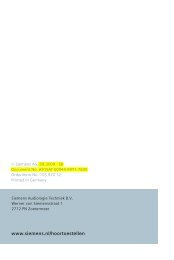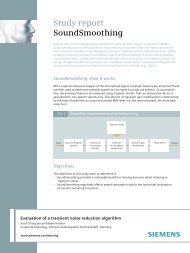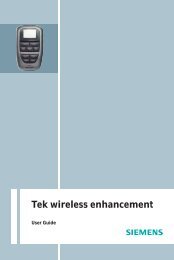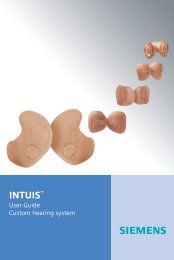BTE User Manual Bil.indd - Siemens Hearing Instruments
BTE User Manual Bil.indd - Siemens Hearing Instruments
BTE User Manual Bil.indd - Siemens Hearing Instruments
You also want an ePaper? Increase the reach of your titles
YUMPU automatically turns print PDFs into web optimized ePapers that Google loves.
Behind-the-Ear<br />
<strong>Hearing</strong> <strong>Instruments</strong><br />
<strong>User</strong> <strong>Manual</strong>
Thank you for purchasing a <strong>Siemens</strong> <strong>Hearing</strong> Instrument.<br />
<strong>Siemens</strong> <strong>Hearing</strong> <strong>Instruments</strong> are designed to achieve the<br />
highest in quality and reliability. We are sure that you will<br />
be very pleased with our product.<br />
If this <strong>Hearing</strong> Instrument is being purchased for an infant or<br />
young child, please confirm with your Audiologist or <strong>Hearing</strong><br />
Care Provider that it is recommended for this purpose and to<br />
ensure appropriate supervision and use of the product.<br />
<strong>Hearing</strong> Aid Information<br />
Serial Number:<br />
Left: Right:<br />
Battery Size:<br />
Left: Right:<br />
Purchase Date:<br />
Left: Right:<br />
Dispenser Info stamped here
Table of Contents<br />
Getting Started<br />
Your hearing instruments ......................... 4<br />
Safety information ................................4<br />
Feature card .................................... 6<br />
Identification information ......................... 7<br />
Identifying the left and right hearing instrument(s). .... 8<br />
Changing the battery. ............................ 9<br />
Battery tips .................................... 10<br />
Using the eCharger ............................. 11<br />
Turning the hearing instrument on or off ............ 12<br />
Attaching the earpiece. ...........................13<br />
Inserting and removing hearing<br />
instrument with an earpiece ......................14<br />
Inserting and removing the hearing<br />
instrument with Life Tube or S-Life Tube. ........... 15<br />
Operating Your <strong>Hearing</strong> Instrument-<br />
Optional Features<br />
Remote Control .................................17<br />
Tek ® /miniTek ..................................18<br />
Changing the volume ............................18<br />
Learning volume preference feature .................19<br />
SoundLearning ® feature ..........................20<br />
Changing the program. ...........................20<br />
Directional microphone system. ....................22<br />
Telecoil ........................................22<br />
AutoPhone ® /Autophone magnet accessory. ...........23<br />
Audio input ....................................24<br />
Battery compartment door lock. ....................27<br />
Operating Your <strong>Hearing</strong> Instrument-<br />
Programmable Features<br />
Wireless functionality. ............................29<br />
Push button on/off. ..............................31<br />
Power on delay. .................................31<br />
Low battery indicator. ............................31<br />
Volume control alert tones ........................32<br />
Program change alert tones. .......................32<br />
Listening Tips . . . . . . . . . . . . . . . . . . . . . . . . . .33<br />
Maintenance and Care . . . . . . . . . . . . . . . . . .35<br />
Performance Checklist . . . . . . . . . . . . . . . . . . 37<br />
Health Considerations . . . . . . . . . . . . . . . . . . .38<br />
Important Notices . . . . . . . . . . . . . . . . . . . . . .39<br />
Warranty and Service . . . . . . . . . . . . . . . . . . .43<br />
2 TABLE OF CONTENTS TABLE OF CONTENTS 3
Getting Started<br />
Your hearing instruments<br />
By wearing your hearing instruments you may once again<br />
enjoy the sounds of the environment and conversation<br />
with your family and friends. Your decision to purchase<br />
hearing instruments manufactured by <strong>Siemens</strong> reflects<br />
the importance you place on quality and reliability.<br />
Your <strong>Siemens</strong> Behind-the-Ear (<strong>BTE</strong>) hearing instruments<br />
are designed for comfort, performance and durability. They<br />
should fit comfortably behind your ears and are attached to<br />
custom-made earpieces or flexible LifeTubes and LifeTips.<br />
Please read this manual carefully to benefit from all the<br />
features of your new hearing system.<br />
Safety information<br />
WARNING<br />
Choking hazard posed by small parts.<br />
• Keep hearing instruments, batteries and accessories out<br />
of children’s reach.<br />
• If swallowed consult a physician or hospital immediately.<br />
• If infants, small children or mentally disabled persons<br />
need to wear hearing instruments ensure adequate<br />
supervision.<br />
• Ensure appropriate supervision when your child is<br />
wearing the hearing instruments.<br />
• Check the integrity of the hearing instruments regularly.<br />
• Ensure that your child does not detach the hearing<br />
instrument from the ear mold.<br />
• Consult your Audiologist or <strong>Hearing</strong> Care Provider if<br />
the housing is deformed.<br />
• Keep the battery compartment locked. Verify the proper<br />
function of the locking mechanism.<br />
WARNING<br />
Risk in explosive environments, e.g., mining areas<br />
• Don’t use your hearing instruments (and remote control)<br />
in areas where there is danger of explosions.<br />
Please read this manual carefully to benefit from all the<br />
features of your new hearing system.<br />
CAUTION<br />
Risk of injury caused by incorrect use of Life Tip<br />
• Always wear the Life Tube with the Life Tip.<br />
• Make sure that the Life Tip is completely attached<br />
to the Life Tip adapter.<br />
• Change the Life Tube or Life Tip when they are cracked.<br />
4 GETTING STARTED GETTING STARTED 5
t<br />
• Carefully insert the Life Tube with the Life Tip into the<br />
ear canal. Be sure not to insert too deeply.<br />
• Use the Life Tube and the Life Tip in the way described<br />
in this user guide.<br />
If the Life Tip remains in the ear, have it removed by a<br />
medical professional.<br />
Feature card<br />
Please refer to the feature card included with this manual.<br />
The feature card is located at the back of this user manual<br />
in a pocket.<br />
The feature card contains important information about the<br />
features in your new hearing instruments. This includes<br />
battery size, serial number location, and features associated<br />
with the operation of your hearing instruments.<br />
More information about these features is located in<br />
the Operation section of this manual.<br />
Identification information<br />
Your hearing instruments have a serial number engraved on<br />
them. The location of the serial number will vary according to<br />
the style of hearing instrument you have chosen. Record the<br />
serial number in the front of this manual for future reference<br />
(Fig. 1).<br />
AY12345<br />
Serial number<br />
Fig. 1: Identification information<br />
The year of manufacture is incorporated into the serial<br />
number. Please note the warranty is based upon the date<br />
of purchase, not the date of manufacture.<br />
The serial number may look similar to this sample: AY12345.<br />
The second letter of this serial number refers to the year of<br />
manufacture of the hearing instrument. The letters Y or A<br />
indicate a 2011 year of manufacture. Your Audiologist or<br />
<strong>Hearing</strong> Care Provider can answer any questions you may<br />
have about the identifying code on your hearing instrument.<br />
Record the serial numbers of each instrument in the space<br />
provided for future reference.<br />
6 GETTING STARTED GETTING STARTED 7
Identifying the left and right<br />
hearing instrument(s)<br />
Your <strong>Siemens</strong> hearing instruments may be color-coded for<br />
your convenience. The left ear hearing instrument may have<br />
a blue typeplate, and the right ear hearing instrument may<br />
have a red typeplate (Fig. 2).<br />
Typeplate<br />
Fig. 2: Location of Typeplate<br />
In addition, on <strong>Siemens</strong> Life <strong>BTE</strong>s, the left ear hearing<br />
instrument has a blue number on the LifeTip Adapter,<br />
and the right ear hearing instrument has a red number<br />
on the LifeTip Adapter (Fig. 3).<br />
Color-coded number<br />
on Tip Adapter<br />
Fig. 3: Location of right and left designator on LifeTip<br />
adapter for <strong>Siemens</strong> Life Product<br />
Changing the battery<br />
Refer to the feature card or check with your Audiologist or<br />
<strong>Hearing</strong> Care Provider to determine the battery size for your<br />
hearing instrument.<br />
To insert the battery into the hearing instrument, use your<br />
fingernail to swivel open the door of the battery compartment.<br />
Place the proper size battery in the battery compartment so<br />
that the “+” symbol on the battery coincides with the “+” mark<br />
on the battery compartment door.<br />
Gently close the battery compartment. Do not force the door<br />
shut. If it does not close easily, check to see if the battery was<br />
inserted properly. When the battery door is completely closed,<br />
your hearing instrument is ready for operation (Fig. 4 and 4.1).<br />
Fig. 4: Inserting the battery<br />
8 GETTING STARTED GETTING STARTED 9<br />
+<br />
-<br />
Battery<br />
Color-coded number<br />
on Tip Adapter
Fig. 4.1: CENTRA Inserting Life the battery<br />
Your hearing instrument may be programmed to inform you<br />
when the battery should be replaced.<br />
Refer to the low battery indicator information in the Operation<br />
section (page 31) of this manual for further information.<br />
Battery tips<br />
• If a battery is accidentally swallowed, seek medical attention<br />
immediately, or call the National Battery Hotline collect at<br />
(202) 625-3333. Quebec residents, call le Centre Antipoison<br />
at (800) 463-5060.<br />
• Always use the recommended battery size for your hearing<br />
instrument. The battery size information for your hearing<br />
instrument is located on the feature card.<br />
• Remove the battery from your instruments when not in use.<br />
This prevents possible damage from expansion or leakage of<br />
the battery, if the instruments are not fully turned off.<br />
• Always carry spare batteries in the event that your current<br />
battery goes dead. Place each spare battery in an individual,<br />
non-metallic container to prevent contact with other<br />
batteries or metal objects, such as keys or coins.<br />
• Follow your local recycling rules for battery disposal.<br />
Using the eCharger<br />
If you have the optional charger, refer to the charger<br />
instruction manual for operating instructions. Use only<br />
the rechargeable batteries delivered with the charger or<br />
available through your Audiologist or <strong>Hearing</strong> Care Provider.<br />
The lifetime of a rechargeable battery is approximately one<br />
year, depending on individual use.<br />
NOTE: Do not attempt to charge standard,<br />
non-rechargeable batteries!<br />
NOTE: The hearing instrument must be turned off then on after<br />
removing from the charger. This is required to turn the<br />
instrument on.<br />
Fig. 4.2: eCharger<br />
10 =<br />
GETTING STARTED GETTING STARTED 11
Turning the hearing instrument on or off<br />
To turn the hearing instrument on, insert a battery into<br />
the hearing instrument and completely close the door.<br />
To turn the hearing instrument off, open the battery door<br />
to the first catch.<br />
<strong>Siemens</strong> hearing instruments may also be programmed<br />
to allow you to turn them on and off using the program<br />
button. Refer to the Operation section (page 31) for further<br />
information.<br />
You can also use an optional remote control to turn the<br />
hearing instruments on and off.<br />
Some <strong>BTE</strong>’s may also have a LED light (Fig.5) near the<br />
battery door.<br />
The LED (optional) shows whether the hearing<br />
instruments are on.<br />
LED can be covered<br />
or programmed on/off<br />
Fig. 5: LED light<br />
LED light<br />
• The LED shines continuously.<br />
The hearing instruments are switched on and<br />
sufficient battery power is available.<br />
• The LED is off.<br />
The hearing instruments are switched off or the<br />
battery must be replaced.<br />
Attaching the earpiece (where provided)<br />
If your earpiece detaches, gently insert the earhook of the<br />
hearing instrument into the tubing of the earpiece supplied<br />
by your Audiologist or <strong>Hearing</strong> Care Provider (Fig. 6).<br />
12 GETTING STARTED GETTING STARTED 13
Fig. 6: Attaching the earpiece<br />
Earhook<br />
Tubing<br />
Inserting and removing hearing<br />
instruments with an earpiece<br />
Hold the earpiece between your thumb and index finger.<br />
Gently work the earpiece into its proper position by adjusting<br />
it until it is firmly seated in your ear. Then lift the hearing<br />
instrument over the top of your ear and adjust it to fit behind<br />
your ear (Fig. 7).<br />
Fig. 7: Inserting the hearing instrument<br />
Earpiece<br />
Lightly push on the back of the ear to help release the<br />
earpiece and gently pull it out (Fig. 8).<br />
Fig. 8: Removing the hearing instrument<br />
Inserting and removing hearing<br />
instruments with LifeTube or S-Life Tube<br />
Hold the LifeTip between your thumb and index finger.<br />
Gently work the LifeTip into its proper position in the ear<br />
canal by adjusting it until it is firmly seated. Then lift the<br />
hearing instrument over the top of your ear and adjust it<br />
to fit behind your ear. Finally, place the retention strand<br />
into the bottom of the ‘bowl’’ of your ear (Fig. 9).<br />
14 GETTING STARTED GETTING STARTED 15
16<br />
LifeTube<br />
LifeTip<br />
Retention Strand<br />
Fig. 9: Inserting the hearing instrument<br />
To remove the instrument, gently pull the LifeTip out of<br />
your ear and carefully lift the hearing instrument off your<br />
ear. Do not pull or tug on the LifeTube to remove the Tip or<br />
instrument, or the LifeTube may become damaged (Fig. 10).<br />
Fig. 10: Removing the hearing instrument<br />
GETTING STARTED<br />
Operating Your <strong>Hearing</strong><br />
Instrument–Optional Features<br />
Refer to the feature card included with this manual to<br />
determine the optional features your hearing instrument<br />
is equipped with. Optional features are listed on the left<br />
column of the feature card, see below (Fig. 11):<br />
Optional<br />
Features<br />
Use the<br />
type of<br />
battery<br />
shown<br />
below<br />
OPTIONAL FEATURES<br />
HEARING<br />
INSTRUMENT<br />
Microphones<br />
Volume control<br />
wheel<br />
Battery<br />
compartment<br />
door<br />
Volume control<br />
Learning volume control<br />
Program button<br />
Directional microphone<br />
Telecoil<br />
AutoPhone ®<br />
Audio input<br />
Battery compartment door lock<br />
ePocket ® remote control<br />
PROGRAMS<br />
Program number Listening environment<br />
1<br />
2<br />
3<br />
4<br />
Refer to the <strong>BTE</strong> <strong>User</strong> <strong>Manual</strong> for information on<br />
Optional Features and Programmable Features.<br />
Fig. 11: FEATURE CARD<br />
Optional features section circled<br />
Remote Control<br />
You may have received an optional remote control with your<br />
hearing instrument. They can be used to change the memory<br />
and volume of your hearing system.<br />
For further information refer to the remote control<br />
instruction manual.<br />
OPERATING YOUR HEARING INSTRUMENT-OPTIONAL FEATURES<br />
Earhook<br />
Audio<br />
input<br />
FEATURE<br />
CARD<br />
PROGRAMMABLE<br />
FEATURES<br />
e2e wireless ®<br />
Push button on/off<br />
Power on delay<br />
Low battery indicator<br />
Volume control<br />
alert tones<br />
Program change<br />
alert tones<br />
17
Tek ® /miniTek Wireless Enhancement<br />
You may have received the optional Tek or miniTek (Fig. 12<br />
and 12.1) Wireless Enhancement with your hearing<br />
instrument. Tek Connect can be used to change the program<br />
and volume of your hearing system. In addition, other<br />
adjustments can also be made to sound quality.<br />
Program<br />
Buttons<br />
Volume down<br />
For detailed information and instructions refer to the Tek or<br />
miniTek instruction manual or ask your Audiologist or <strong>Hearing</strong><br />
Care Provider.<br />
Changing the volume<br />
Your <strong>Siemens</strong> hearing instrument is fully automatic.<br />
However, it may be equipped with a volume control for<br />
manual adjustment.<br />
MICRORIC TEK<br />
P1 P2<br />
P3 P4 P5<br />
Volume up<br />
Fig. 12: Tek Connect remote control<br />
Fig. 12.1: miniTek remote control<br />
Volume control<br />
• Rotate the volume control up to<br />
increase the volume.<br />
• Rotate the volume control down<br />
to decrease the volume.<br />
Rocker switch<br />
• Press up to increase the volume.<br />
• Press down to decrease the volume.<br />
Fig. 13: Volume Control<br />
You may hear soft beeps each time you change the volume<br />
and a three beep warning when the volume limit has been<br />
reached. These tones can be enabled or disabled by your<br />
Audiologist or <strong>Hearing</strong> Care Provider.<br />
You may have received an optional remote control with your<br />
hearing instrument. Refer to the remote control user guide.<br />
Learning volume preference feature<br />
(if applicable)<br />
You hearing instrument may have a learning volume control.<br />
The learning volume preference feature retains information<br />
on when and how you adjust the volume on your <strong>Siemens</strong><br />
hearing instruments programmed for manual adjustment.<br />
Over time, your hearing system will automatically adjust to<br />
that preferred volume in each listening program. For more<br />
information about this feature, speak with your Audiologist<br />
or <strong>Hearing</strong> Care Provider.<br />
18 OPERATING YOUR HEARING INSTRUMENT-OPTIONAL FEATURES OPERATING YOUR HEARING INSTRUMENT-OPTIONAL FEATURES 19<br />
2
SoundLearning ® feature (if applicable)<br />
SoundLearning allows all the functionality of the learning<br />
volume control preference feature above and also retains your<br />
sound quality preferences independently for loud and soft<br />
sounds. For more information about this feature, speak to<br />
your Audiologist or <strong>Hearing</strong> Care Provider.<br />
Changing the program<br />
Your <strong>Siemens</strong> hearing instrument may have up to 5<br />
memories, also called hearing programs. Each program<br />
is different and designed to help you hear better in specific<br />
listening situations. Four of the five programs are selected<br />
with the program button of your hearing instrument. The<br />
fifth memory is activated automatically when an audio shoe<br />
is attached to the hearing instrument (refer to the “Audio<br />
Input” section, page 23). For <strong>Siemens</strong> Explorer ® and Motion ® ,<br />
when an audio shoe is attached all 5 programs can be<br />
accessed via the program button.<br />
When initially turned on (after the battery compartment door<br />
is closed), the microphone is ON and ready for general use.<br />
The default is Program 1. Your Audiologist or <strong>Hearing</strong> Care<br />
Provider will provide you with the number of programs most<br />
appropriate for your needs. Each time you press the program<br />
button on the instrument, the instrument changes to the next<br />
program. The program change may be confirmed by alerting<br />
tones or beeps that correlate to the program you are in. That<br />
means if you select Program 3, then the hearing instrument<br />
beeps 3 times (Fig. 14).<br />
Via push button<br />
• Press the push button to<br />
switch to the next program.<br />
Your Audiologist or <strong>Hearing</strong> Care Provider may list your<br />
personal programs on the feature card (Fig. 15).<br />
Programs<br />
HEARING<br />
INSTRUMENT<br />
Volume control<br />
Learning volume control<br />
Program button<br />
Directional microphone<br />
Telecoil<br />
AutoPhone ®<br />
Audio input<br />
Battery compartment door lock<br />
ePocket ® remote control<br />
The optional remote control can also be used to change<br />
the program.<br />
20 OPERATING YOUR HEARING INSTRUMENT-OPTIONAL FEATURES OPERATING YOUR HEARING INSTRUMENT-OPTIONAL FEATURES 21<br />
Use the<br />
type of<br />
battery<br />
shown<br />
below<br />
Microphones<br />
Volume control<br />
wheel<br />
Battery<br />
compartment<br />
door<br />
OPTIONAL FEATURES<br />
Fig. 14: Changing the Program<br />
Via remote control<br />
• Refer to the remote control user guide.<br />
Earhook<br />
Audio<br />
input<br />
PROGRAMS<br />
Program number Listening environment<br />
1<br />
2<br />
3<br />
4<br />
Refer to the <strong>BTE</strong> <strong>User</strong> <strong>Manual</strong> for information on<br />
Optional Features and Programmable Features.<br />
FEATURE<br />
CARD<br />
PROGRAMMABLE<br />
FEATURES<br />
e2e wireless ®<br />
Push button on/off<br />
Power on delay<br />
Low battery indicator<br />
Volume control<br />
alert tones<br />
Program change<br />
alert tones<br />
Fig. 15: FEATURE CARD<br />
Program information section highlighted
Directional microphone system<br />
According to your hearing needs, your <strong>Siemens</strong> hearing<br />
instrument may be adjusted to focus on sounds in front of<br />
you (directional mode) for when you are having a face-to-face<br />
conversation in a noisy environment. The hearing system may<br />
also be adjusted for when you are in more quiet environments<br />
and want to hear the sounds around you (omnidirectional).<br />
Your Audiologist or <strong>Hearing</strong> Care Provider may program the<br />
operation of the directional microphone system to function<br />
automatically or in conjunction with the program button or<br />
remote control based on your particular hearing requirements.<br />
Telecoil<br />
Your <strong>Siemens</strong> hearing instrument may be equipped with a<br />
T-coil (telecoil) for telephone use. It may be programmed to<br />
work in a specific listening program in conjunction with the<br />
program button. In the T-coil mode, place the telephone<br />
receiver close to your hearing instrument for best reception.<br />
By trying various positions of the telephone receiver, you<br />
will discover what works best for you. Your Audiologist or<br />
<strong>Hearing</strong> Care Provider can advise you on the proper use of<br />
the T-coil.<br />
Note: In order for the telecoil to function properly, your telephone<br />
must be “hearing aid compatible”. Check your telephone’s<br />
instruction manual to find out whether your phone has<br />
this capability.<br />
AutoPhone ®<br />
The AutoPhone option allows the telecoil to automatically<br />
engage when a “hearing aid compatible” telephone handset<br />
is brought close to the hearing instrument.<br />
To operate, bring the telephone handset close to the hearing<br />
instrument. The telecoil will automatically engage to the<br />
presence of the electromagnetic signal from the telephone.<br />
When you are finished speaking on the phone, move the<br />
handset away from the hearing instrument and the<br />
microphone mode will re-establish itself.<br />
AutoPhone magnet accessory<br />
There is an AutoPhone magnet accessory available for your<br />
telephone that can be used with the AutoPhone feature of<br />
your hearing instrument. Ask your Audiologist or <strong>Hearing</strong> Care<br />
Provider about this accessory and if it is appropriate for your<br />
individual hearing care needs.<br />
You must use the original magnet provided with your hearing<br />
instrument. Using other magnets may cause irreversible<br />
damage to the electronics of your hearing instrument.<br />
Note : When magnets are properly cared for, they are safe to use<br />
and can last a lifetime. However, the following guidelines<br />
should be followed while using these magnets.<br />
• Magnets can pose risks to electronics and magnetic storage<br />
media when placed in close proximity.<br />
• Be careful not to place magnets near computers, color<br />
monitors, television sets, floppy disks, video/audio tape,<br />
and other electronic equipment.<br />
22 OPERATING YOUR HEARING INSTRUMENT-OPTIONAL FEATURES OPERATING YOUR HEARING INSTRUMENT-OPTIONAL FEATURES 23
• Magnets may interfere with the operation of life support<br />
systems, such as pacemakers, magnetic valves, etc.<br />
• Make certain to maintain a distance of at least 4 inches<br />
between the magnet and the area of your support system.<br />
• Keep magnets out of the reach of children or pets.<br />
• If accidentally swallowed, seek medical attention.<br />
Audio input<br />
Your <strong>Siemens</strong> hearing instruments may be equipped with<br />
audio input capability. This enables you to connect your<br />
hearing instruments to other audio sources such as an FM<br />
system, tape recorder, television, or infrared system. It can<br />
be useful for adults in difficult listening situations and for<br />
children in classrooms. Because the sound is coming directly<br />
from the sound source to the hearing instrument, the signal is<br />
clearer and unaffected by poor room acoustics. Ask your<br />
Audiologist or <strong>Hearing</strong> Care Provider if this feature may be<br />
appropriate for your needs.<br />
There are two methods for attaching and removing the<br />
audio input shoe. Refer to the next page for the method<br />
you should follow.<br />
WARNING<br />
Risk of injuries caused by electric shock!<br />
Connect audio input only to devices conform to<br />
IEC 60065 (IEC-Standard for audio, video and<br />
other electronic devices).<br />
ATTACHMENT METHOD 1:<br />
Attaching and removing the audio input shoe (Fig. 16):<br />
1. Using the fingernail of your thumb or index finger, open<br />
the battery compartment door to the first catch.<br />
2. Using your fingernail, lift up the audio input flap,<br />
exposing the gold contacts.<br />
3. Close the battery compartment door.<br />
4. Place the gold contacts of the audio input shoe on the<br />
gold contacts under the audio input flap on the <strong>BTE</strong>.<br />
5. Gently push the audio input shoe into place by pressing<br />
the audio input shoe toward the underside of the hearing<br />
instrument until it snaps into place.<br />
Note: When controlling your <strong>Siemens</strong> hearing instruments with an<br />
audio input shoe attached to one or both hearing instruments,<br />
the memory button on the remote control or on the instruments<br />
will not change programs. It can be used to select the audio<br />
mode only (audio input only, microphone only, or mixed mode)<br />
if programmed accordingly by your Audiologist or <strong>Hearing</strong> Care<br />
Provider. The volume can be changed using the volume control<br />
wheel or the remote control.<br />
Fig. 16: Method 1-Attaching the audio shoe<br />
24 OPERATING YOUR HEARING INSTRUMENT-OPTIONAL FEATURES OPERATING YOUR HEARING INSTRUMENT-OPTIONAL FEATURES 25
To remove the audio input shoe, hold the <strong>BTE</strong> with one hand<br />
and the audio shoe with the other hand. Gently pull the audio<br />
shoe off, guiding it from the underside towards the gold<br />
contacts. Close the audio input flap.<br />
ATTACHMENT METHOD 2:<br />
Attaching and removing the audio input shoe (Fig. 17):<br />
To attach an audio input shoe, open the battery compartment<br />
to the first catch.<br />
1. Hook the audio input shoe in from the front.<br />
2. Gently press it into place until the audio shoe presses<br />
against the underside of the hearing instrument.<br />
3. The audio input shoe is now in place.<br />
Fig. 17: Method 2-Attaching the audio input shoe<br />
Note: When controlling your <strong>Siemens</strong> hearing instruments with<br />
an audio input shoe attached to one or both hearing<br />
instruments, the memory button on the remote control<br />
or on the instruments will not change programs. It can<br />
be used to select the audio mode only (audio input only,<br />
microphone only, or mixed mode) if programmed accordingly<br />
by your Audiologist or <strong>Hearing</strong> Care Provider (not applicable<br />
for Motion and <strong>Siemens</strong> Explorer). The volume can be changed<br />
using the volume control wheel or the remote control.<br />
To remove the audio input shoe, press it toward the front of<br />
the hearing instrument and gently unhook it.<br />
Battery compartment door lock<br />
Your <strong>Siemens</strong> hearing instruments may be equipped with a<br />
lock that prevents the unintentional opening of the battery<br />
compartment. This feature is located on the inner side of the<br />
battery compartment door. To lock the battery compartment,<br />
open the compartment door to the first catch. Push the slide<br />
toward the right. To unlock the battery compartment for<br />
opening, open the door to the first catch and push the slide<br />
to the left (Fig. 18).<br />
Your Audiologist or <strong>Hearing</strong> Care Provider can instruct you on<br />
the use of this feature, if required.<br />
Locked Unlocked<br />
Fig. 18: Battery compartment door lock<br />
26 OPERATING YOUR HEARING INSTRUMENT-OPTIONAL FEATURES OPERATING YOUR HEARING INSTRUMENT-OPTIONAL FEATURES 27
28<br />
The EXPLORER ® 500 P is equipped with a different battery<br />
compartment lock (Fig. 19). Use a small screw driver to lock<br />
and unlock the battery compartment door.<br />
To Lock<br />
• Push the small slide to the right. The battery<br />
compartment is now locked.<br />
To Unlock<br />
• Push the small slide to the left. The battery<br />
compartment is now unlocked.<br />
Unlocked<br />
Locked<br />
Fig. 19: EXPLORER ® 500 P compartment door,<br />
locked, unlocked<br />
Ask your Audiologist and <strong>Hearing</strong> Care Provider if you<br />
need assistance.<br />
OPERATING YOUR HEARING INSTRUMENT-OPTIONAL FEATURES<br />
Wireless functionality (if applicable)<br />
Your hearing instrument may be equipped with wireless<br />
functionality. This provides synchronization between<br />
two hearing instruments. If you change the program or<br />
volume on one instrument, the other is automatically<br />
changed. In addition, wireless technology automatically<br />
adjusts the system to change both hearing instruments<br />
simultaneously to adapt to different listening situations.<br />
The wireless functionality also enables use of an optional<br />
remote control.<br />
Note: The performance of the e2e® wireless 2.0 could be temporarily<br />
affected when in close proximity to electromagnetic noise<br />
sources, such as a computer monitor or television. Move away<br />
from the noise source if you experience difficulty.<br />
Technical information for e2e 2.0 wireless function:<br />
Operating frequency : Fc = 3.28 MHz; Maxium field strength: –7 dB<br />
µA/m at 10m meters.<br />
Changes or modifications not expressly approved by the party<br />
responsible for compliance could void the users authority to operate<br />
the equipment.<br />
This Class B digital apparatus complies with Part 15 of FCC Rules.<br />
Operation is subject to the following two conditions: (1) this device<br />
may not cause interference,and (2) this device must accept any<br />
interference, including interference that may cause undesired<br />
operation of the device. FCC: SGI-WL002<strong>BTE</strong><br />
OPERATING YOUR HEARING INSTRUMENT-PROGRAMMABLE FEATURES<br />
29
This equipment has been tested and found to comply with the<br />
limits for a Class B digital device, pursuant to Part 15 of the<br />
FCC Rules.<br />
These limits are designed to provide reasonable protection<br />
against harmful interference in a residential installation. This<br />
equipment generates, uses and can radiate radio frequency<br />
energy and, if not installed and used in accordance with<br />
the instructions, may cause harmful interference to radio<br />
communications. However, there is no guarantee that<br />
interference will not occur in a particular installation. If<br />
this equipment does cause harmful interference to radio<br />
or television reception, which can be determined by<br />
turning the equipment off and on, the user is encouraged<br />
to try to correct the interference by one or more of the<br />
following measures:<br />
• Reorient or relocate the receiving antenna.<br />
• Increase the separation between the equipment<br />
and receiver.<br />
• Connect the equipment into an outlet on a circuit different<br />
from that to which the receiver is connected.<br />
• Consult the dealer or an experienced radio/TV technician<br />
for help.<br />
Push button on/off<br />
Your <strong>Siemens</strong> hearing instruments may be programmed to<br />
allow you to turn them on and off using the program button.<br />
To turn the instrument off using the program button, press<br />
and hold the button for 3–5 seconds. To turn it back on, press<br />
and hold the program button for 3–5 seconds. Please note<br />
that after having turned the hearing instrument off using the<br />
program button, you must wait approximately 10 seconds for<br />
the system to reset before turning it back on again by using<br />
the program button.<br />
Power on delay<br />
Your hearing instruments may be equipped with an advanced<br />
power-on delay feature. This feature delays sound from<br />
entering your hearing instruments when they are first<br />
turned on so that you may insert the instruments into your<br />
ears without experiencing unpleasant feedback (whistling).<br />
Low battery indicator<br />
Your hearing instrument may be programmed to inform you<br />
when the battery should be replaced for best performance.<br />
You may hear an intermittent series of beeps and/or<br />
experience low amplification power or volume. Change<br />
the battery immediately if either of these should occur.<br />
30 OPERATING YOUR HEARING INSTRUMENT-PROGRAMMABLE FEATURES OPERATING YOUR HEARING INSTRUMENT-PROGRAMMABLE FEATURES 31
32<br />
Volume control alert tones<br />
Your hearing instrument may be programmed to inform you<br />
of changes to volume. You may hear soft beeps each time<br />
you change the volume and a three beep warning when<br />
the volume limit has been reached. Once the maximum or<br />
minimum volume has been reached, further changes in that<br />
direction will have no effect.<br />
Program change alert tones<br />
Your hearing instrument may be programmed to inform you<br />
of changes to the program. The program change may be<br />
confirmed by alert tones or beeps that correlate to the<br />
program you are in. That means if you select Program 3,<br />
the hearing instrument will beep 3 times.<br />
OPERATING YOUR HEARING INSTRUMENT-PROGRAMMABLE FEATURES<br />
Listening Tips<br />
• Give yourself time to become accustomed to your new<br />
hearing instruments. During this period, you may prefer<br />
to wear your hearing instruments for only a portion<br />
of the day, and then gradually increase your usage<br />
throughout your normal routine each day.<br />
• You may find that a quiet environment is more comfortable<br />
in the beginning of the adjustment period. Gradually<br />
introduce new listening environments as your ears<br />
become accustomed to hearing instrument amplification.<br />
• If you are a new hearing instrument user, be aware that<br />
there are sounds, both pleasant and unpleasant, that you<br />
may not have heard in a long time.<br />
• Ask the people with whom you are conversing to attract<br />
your attention before speaking to you. If you don’t<br />
understand what someone has said, ask the speaker<br />
to slow down or say it in another way, but not to shout.<br />
• In noisy or difficult environments, you may find it easier to<br />
understand speech by facing the speaker. Focus on reading<br />
lips and observing facial expressions and body language.<br />
Be aware that in some situations, it may be too noisy to<br />
understand what is being said.<br />
LISTENING TIPS<br />
33
34<br />
• Encourage one person to speak at a time when you are<br />
engaging in group conversation.<br />
• Listen to radio and television programs as you<br />
normally would.<br />
• Experiment finding the best place to sit for optimum<br />
hearing in public places like the theater, school auditoriums,<br />
religious services, etc. If possible, choose a seat that is far<br />
away from any source of distracting noise, such as a fan<br />
or an open window, and where you have a good view of<br />
the person speaking.<br />
LISTENING TIPS<br />
Maintenance and Care<br />
<strong>Hearing</strong> instruments should be cleaned daily. You can wipe<br />
them with a tissue or a soft cloth. Do not use water, alcohol,<br />
benzene, or any other liquid or household cleaning agent to<br />
clean your instruments as it may cause damage to them.<br />
Always store your hearing instruments (and earpieces,<br />
LifeTube, or LifeTip) inside the case. A soft carrying pouch<br />
is also included for your convenience when traveling.<br />
Remove the batteries to prevent damage from corrosion when<br />
storing hearing instruments for an extended period of time.<br />
Store the instruments in a dry area, preferably at room<br />
temperature. If you perspire heavily or live in an area of<br />
high humidity, you may find it beneficial to use a DRI-AID<br />
kit when the instruments are not in use. This product can be<br />
purchased from your Audiologist or <strong>Hearing</strong> Care Provider.<br />
Note: The charger can be used instead of the DRI-AID kit. Refer to<br />
the Maintenance and Care section of the charger instruction<br />
manual for further information.<br />
CAUTION<br />
Never immerse your hearing instruments in water!<br />
Note: Your hearing instrument is sensitive to extreme heat, high<br />
humidity, strong magnetic fields (>0.1T), X-rays and<br />
mechanical stress.<br />
MAINTENANCE AND CARE<br />
35
36<br />
• Do not expose your hearing instrument to extreme<br />
temperature or high humidity.<br />
• Do not leave it in direct sunlight.<br />
• Do not wear it in the shower or when you apply makeup,<br />
perfume, aftershave, hairspray or suntan lotion.<br />
• Do not wear your hearing instruments when you are<br />
exposed to short-waves, a strong magnetic field, a<br />
high frequency field or X-rays.<br />
• Do not place your hearing instruments in a<br />
microwave oven.<br />
* Aquaris <strong>Instruments</strong> Recommendations<br />
Aquaris instruments achieved International Protection Rating<br />
(IP57) per the International Electrotechnical Commission<br />
(IEC) 60529 Standard. Your instrument can be completely<br />
submerged in water up to 3 feet for 30 minutes with no<br />
damage to instrument, and dust will not interfere with the<br />
operation of the device.<br />
Special recommendations for water activities:<br />
• When you are swimming, use an earhook with a<br />
custom-made, unvented, soft ear mold.<br />
• Remove hearing instruments before diving and playing<br />
water sports that cause your hearing instruments to be<br />
constantly immersed in water.<br />
MAINTENANCE AND CARE<br />
Performance Checklist<br />
Problem Cause Possible Solution<br />
Weak or dead battery Insert new battery<br />
Sound is<br />
weak<br />
Instrument<br />
emits<br />
whistling<br />
sound<br />
Sound is<br />
distorted<br />
Instrument<br />
does not<br />
work<br />
Volume too low<br />
Earpiece or LifeTip clogged<br />
with wax or debris<br />
Microphone clogged<br />
Improper seating in ear<br />
Volume too high<br />
Clogged with wax or<br />
excessive wax in ears<br />
Volume too high<br />
Weak battery<br />
Instrument not turned on<br />
Battery compartment<br />
not completely closed<br />
Dead battery<br />
Battery polarity reversed<br />
Power-on delay is active<br />
If the solutions in this checklist do not address a particular<br />
issue you are having with your hearing instruments,<br />
consult your Audiologist or <strong>Hearing</strong> Care Provider.<br />
PERFORMANCE CHECKLIST<br />
Clean instrument, earpiece,<br />
or change LifeTip<br />
Clean instrument, earpiece<br />
or change LifeTip<br />
Wipe hearing instrument<br />
with cloth<br />
Try reinserting earpiece or<br />
LifeTip until it fits securely<br />
Lower the volume<br />
Clean earpiece or replace LifeTip<br />
OR contact your Audiologist or<br />
<strong>Hearing</strong> Care Provider<br />
Lower the volume<br />
Replace battery<br />
Turn instrument on<br />
Gently close the battery<br />
compartment completely<br />
Replace battery<br />
Make sure battery is<br />
inserted correctly<br />
Wait 15 seconds and<br />
check again<br />
37
38<br />
Health Considerations<br />
If soreness or skin irritation develops, discontinue wearing your<br />
hearing instrument, and bring the instrument and<br />
earpiece to your Audiologist or <strong>Hearing</strong> Care Provider.<br />
Minor fit adjustments or earpiece modification can often<br />
correct this condition. If soreness persists, discontinue<br />
wearing the hearing instrument and see your physician.<br />
If excessive earwax accumulates when wearing your<br />
hearing instruments, consult your Audiologist or <strong>Hearing</strong><br />
Care Provider.<br />
HEALTH CONSIDERATIONS<br />
Important Notices<br />
Children with hearing loss<br />
In addition to seeing a physician for a medical evaluation,<br />
a child with a hearing loss should be directed to an<br />
Audiologist, since hearing loss may cause problems in<br />
language development and the educational and social<br />
growth of a child.<br />
An Audiologist is qualified by training and experience to<br />
assist in the evaluation and rehabilitation of a child with<br />
a hearing loss.<br />
Important notice for prospective<br />
hearing instrument wearers<br />
Good health practice requires that a person with a hearing<br />
loss have a medical evaluation by a licensed physician<br />
(preferably a physician who specializes in diseases of<br />
the ear) before purchasing hearing instruments. Licensed<br />
physicians who specialize in diseases of the ear are often<br />
referred to as Otolaryngologists, Otologists, or<br />
Otorhinolaryngologists.<br />
The purpose of a medical evaluation is to assure that all<br />
medically treatable conditions that may affect hearing are<br />
identified and treated before hearing instruments are<br />
purchased.<br />
IMPORTANT NOTICES<br />
39
Following the medical evaluation, the physician will give you<br />
a written statement that your hearing loss has been medically<br />
evaluated and that you may be considered a candidate for<br />
hearing instruments.<br />
The physician will refer you to an Audiologist or <strong>Hearing</strong> Care<br />
Provider, as appropriate, for a hearing instrument evaluation.<br />
The Audiologist or <strong>Hearing</strong> Care Provider will conduct a<br />
hearing instrument evaluation to assess your ability to hear<br />
with and without hearing instruments. The hearing instrument<br />
evaluation will enable the Audiologist or <strong>Hearing</strong> Care Provider<br />
to select and fit hearing instruments for your individual needs.<br />
If you have reservations about your ability to adapt to<br />
amplification, you should inquire about the availability of a<br />
trial-rental or purchase-option program. Many Audiologists<br />
or <strong>Hearing</strong> Care Providers now offer programs that permit<br />
you to wear a hearing instrument for a period of time for a<br />
nominal fee after which you may decide if you want to<br />
purchase the hearing instrument.<br />
Only those fully informed adults who have either obtained<br />
medical evaluation from a licensed physician or signed<br />
a waiver statement declining the medical evaluation for<br />
religious or personal beliefs that preclude consultation with<br />
a physician may purchase hearing instruments. The exercise<br />
of such a waiver is not in your best health interest and its use is<br />
strongly discouraged.<br />
Warning to Audiologists or<br />
<strong>Hearing</strong> Care Providers<br />
An Audiologist or <strong>Hearing</strong> Care Provider should advise a<br />
prospective hearing instrument user to consult promptly<br />
with a licensed physician (preferably an ear specialist) before<br />
dispensing a hearing instrument if the Audiologist or <strong>Hearing</strong><br />
Care Provider determines through inquiry, actual observation,<br />
or review of any other available information concerning the<br />
prospective user that the prospective user has any of the<br />
following conditions:<br />
• Visible congenital or traumatic deformity of the ear.<br />
• Acute or chronic dizziness.<br />
• History of active drainage from the ear within the previous<br />
90 days.<br />
• History of sudden or rapidly progressive hearing loss within<br />
the previous 90 days.<br />
• Unilateral hearing loss of sudden or recent onset within<br />
the previous 90 days.<br />
• Audiometric air-bone gap equal to or greater than<br />
15 decibels (dB) at 500 Hertz (Hz), 1000 Hz, and 2000 Hz.<br />
• Visible evidence of significant cerumen accumulation or<br />
a foreign body in the ear canal.<br />
• Pain or discomfort in the ear.<br />
40 IMPORTANT NOTICES IMPORTANT NOTICES 41
42<br />
Special care should be exercised in selecting and fitting<br />
a hearing instrument whose maximum sound pressure<br />
level exceeds 132 decibels (dB), because there may be<br />
risk of impairing the remaining hearing of the hearing<br />
instrument user.<br />
A hearing instrument will not restore normal hearing and<br />
will not prevent or improve a hearing impairment resulting<br />
from organic conditions.<br />
The use of hearing instruments is only part of hearing<br />
rehabilitation and may need to be supplemented by auditory<br />
training and instructions in lip reading. Consistent use of<br />
amplification is recommended. In most cases, infrequent use<br />
of hearing instruments does not permit the wearer to attain<br />
the full benefit of amplification.<br />
IMPORTANT NOTICES<br />
Warranty and Service<br />
Your <strong>Siemens</strong> <strong>BTE</strong> hearing instrument, with the exception<br />
of the battery, is covered by a comprehensive warranty. All<br />
covered instrument parts received for warranty service at<br />
an authorized <strong>Siemens</strong> Service Center will be repaired or<br />
replaced with new or reconditioned components, without<br />
charge, to meet the performance specifications for that model.<br />
This warranty does not cover malfunctions due to unusual<br />
wear and tear or mistreatment of the instrument such as<br />
physical shock, excessive wax build-up, or tampering with the<br />
instrument, any of which voids all warranties. Your Audiologist<br />
or <strong>Hearing</strong> Care Provider may charge a service fee for<br />
processing warranty service.<br />
Warranty service must only be performed by an authorized<br />
<strong>Siemens</strong> Service Center. Service performed by unauthorized<br />
service depots voids this warranty and repairs so necessitated<br />
will be done on a parts and labor cost basis.<br />
Please refer to the warranty card included with your hearing<br />
instruments for warranty period effective dates.<br />
Your <strong>Siemens</strong> <strong>BTE</strong> hearing instruments may have additional<br />
loss and damage coverage. Please consult your Audiologist or<br />
<strong>Hearing</strong> Care Provider to determine if this is applicable to your<br />
hearing instruments.<br />
WARRANTY AND SERVICE<br />
43
44<br />
Procedure<br />
In case of malfunction or loss, take your <strong>Siemens</strong> hearing<br />
instrument and/or proof of purchase to the Audiologist or<br />
<strong>Hearing</strong> Care Provider from whom the unit was purchased.<br />
If factory service or replacement is needed, your Audiologist<br />
or <strong>Hearing</strong> Care Provider will forward the unit to an authorized<br />
<strong>Siemens</strong> Service Center.<br />
Extended warranty programs<br />
<strong>Siemens</strong> offers extended warranty and service programs for<br />
your hearing instruments. Please consult with your Audiologist<br />
or <strong>Hearing</strong> Care Provider for more details on these programs.<br />
IMPORTANT<br />
This warranty gives you specific legal rights and you may<br />
have other rights which may vary from location to location.<br />
For more information, contact your local Department of<br />
Consumer Affairs.<br />
IMPORTANT NOTICES<br />
Guide d’utilisation des<br />
aides auditives de type<br />
contour d’oreille
Information in this brochure is subject<br />
to change without notice.<br />
Copyright © 2011 <strong>Siemens</strong> <strong>Hearing</strong><br />
<strong>Instruments</strong>, Inc. All rights reserved.<br />
Les renseignements contenus dans le<br />
présent guide peuvent faire l’objet de<br />
modifications sans préavis.<br />
Tous droits réservés © 2011 <strong>Siemens</strong><br />
<strong>Hearing</strong> <strong>Instruments</strong>, Inc.<br />
Legal Manufacturer in Canada<br />
<strong>Siemens</strong> <strong>Hearing</strong> <strong>Instruments</strong> Inc .<br />
320 Pinebush Road<br />
Cambridge, ON, N1T 1Z6<br />
www.siemens.ca/hearing<br />
<strong>Siemens</strong> Appareils auditifs inc .<br />
320 Pinebush Road<br />
Cambridge (Ontario) N1T 1Z6<br />
www.siemens.ca/hearing<br />
www .siemens .com/hearing<br />
Legal Manufacturer<br />
<strong>Siemens</strong> Audiologische Technik GmbH<br />
Gebberstrasse 125<br />
91058 Erlangen<br />
Germany<br />
Global Business Unit<br />
<strong>Siemens</strong> Audiologische Technik GmbH<br />
Gebberstrasse 125<br />
91058 Erlangen<br />
Germany<br />
Phone: +49 9131 308 0<br />
Global <strong>Siemens</strong> Headquarters<br />
<strong>Siemens</strong> AG<br />
Wittelsbacherplatz 2<br />
80333 Muenchen<br />
Germany<br />
Global <strong>Siemens</strong><br />
Healthcare Headquarters<br />
<strong>Siemens</strong> AG<br />
Healthcare Sector<br />
Henkestrasse 127<br />
91058 Erlangen<br />
Germany<br />
Phone: +49 9131 84 0<br />
www.siemens.com/healthcare<br />
10295007 4/11 2.0 LC 0K<br />
SHI/11100-10
















